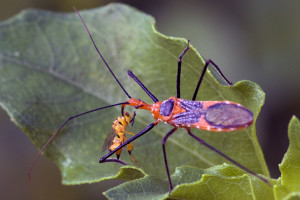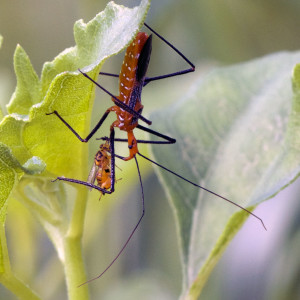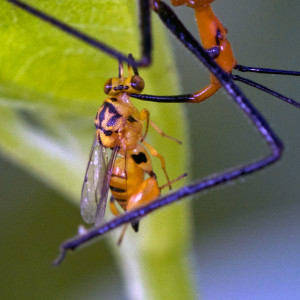The wasps in the superfamily Chalcidoidea may be small, but they’re not invisible, nor are they invincible. At least not to a hunter as skilled as the milkweed assassin bug, Zelus longipes:

This photo marks the first time in years of trying that I was able to see one of these guys in the yard with a meal. I’ve seen them in the yard before, waiting around on leaves with their sticky forelegs raised up (always sidling around the plant to be on the opposite side of the leaf or stem from me and the camera), but until today I’d never seen one with a capture!
The legs and antennae of this insect are enormously long; presumably the long antennae aid in identifying and sorting prey from non-prey items. The length of these appendages also probably enables them to keep their distance from any dangerous insects they may encounter.
Adults have wings, so they do fly, but apparently not so well (video captured by a YouTuber in Broward County a few years ago):
As for what the bug from this morning is eating: yes, indeed, it is one of those conurid wasps, family Chalcidoidea, that I’ve just started paying more attention to:

I know some butterfly enthusiasts who worry about the presence of these predatory wasps in their gardens; they’ve probably witnessed countless episodes of caterpillars being used as hosts for the parasitoid larvae. It’s certainly not pretty, but it sure beats industrial pest control!
And, as the above picture demonstrates, these “nasty” wasps don’t have it all that good, either.
Finding this example of a predator becoming prey is a bit ironic because I had spent a good part of the morning trying to find a live one of these wasps so I could get a decent picture of it (they’re quite elusive, moving quickly from leaf to leaf as they search for prey items, making it hard for me to get a decent shot at one). I was not expecting to get a helping hand (or piercing-sucking mouthpart) from an assassin bug! Nor was I looking for a shot of the milkweed assassin bug, as I had already added it to my photo archives (although I hadn’t written it up anywhere except my Encyclopedia Taxonomica, so perhaps this post can serve for that as well).
Of course, it wasn’t all that helpful: these assassin bugs are wary creatures as well, and I was never able to maneuver my camera close enough to get a really, really good shot.
You can read all about this beneficial garden insect at the UF/IFAS web site. According to that site, these bugs (true bugs, so the name is apt, for once) are “generalist predators feeding on a wide range of soft-bodied prey in garden and fields such as mosquitoes, flies, earthworms, cucumber beetles and caterpillars.”
And important to remember when dealing with any true bug, they have piercing sucking mouthparts. UF/IFAS reminds us that “While not a threat to humans, if not handled properly, a Z. longipes ‘bite’ can cause a burning sensation with swelling that may last for several days.”
In the meantime, here are some more pictures of the wasp; a living specimen would have much brighter yellow eyes:

Etymology
The taxonomy of Zelus longipes goes all the way back to Linnaeus himself (1767), although the actual genus name now used for it comes from Fabricius (1803). The specific epithet means “long-legged” (strictly speaking, long-footed), a fact which you can probably appreciate from the photos. Zela is an ancient Greek (Thracian, actually) word for wine, but it’s more likely that the genus is named for Zelus, one of the attendants of Zeus’s throne, who was supposed to have personified “zeal.” (This deity was the less famous sibling of Nike, “winged victory.”)

Ben,
I would like to use your picture of the assassin bug feeding on a Chalcid for the LSU AgCenter extension website. It would be included in a short write up describing assassin bugs as biological control agents. It is for educational purposes only, and all photo credit will be given to you.
Thank you,
Blake Wilson
Hi, Blake. Sounds fine to me; appreciate it!